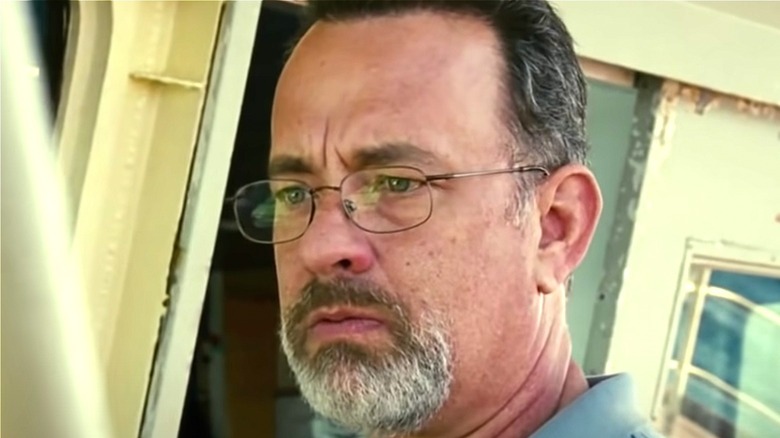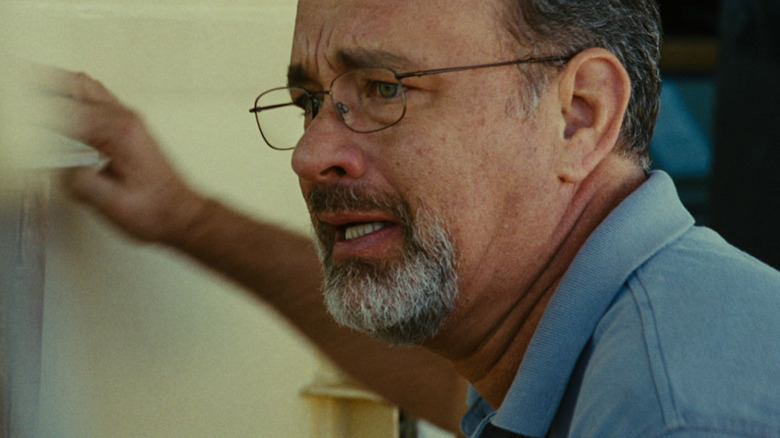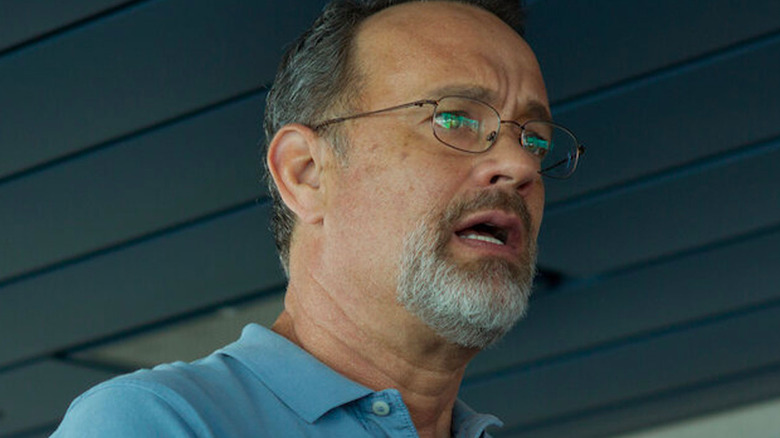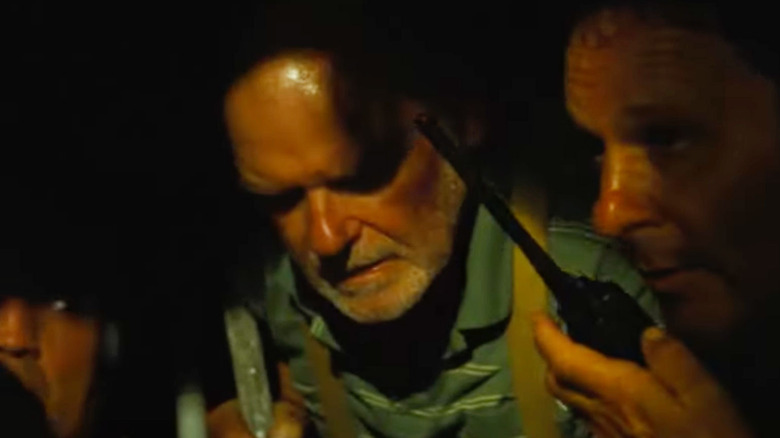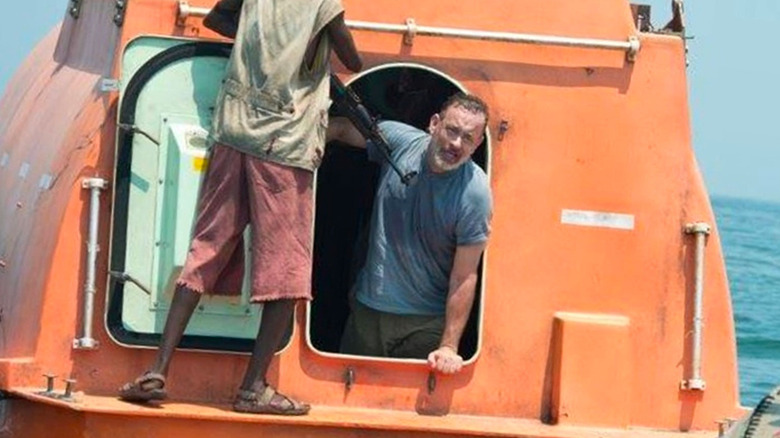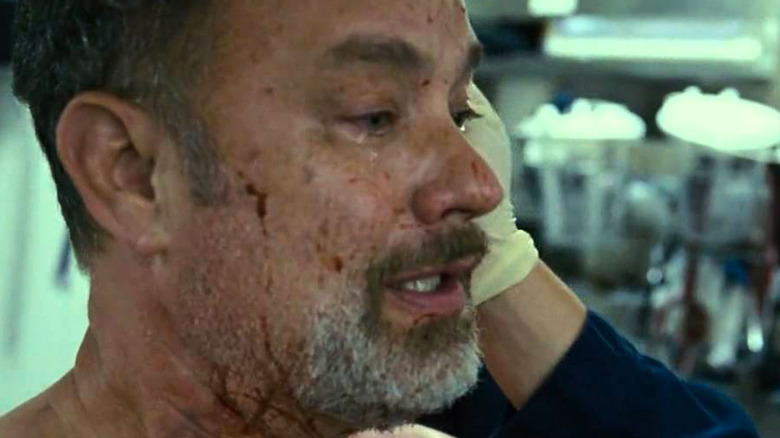How Accurate Is Captain Phillips?
In 2013, routine "Bourne" boss director Paul Greengrass took to the Guardafui Channel with Tom Hanks in the tense and heartwrenching drama, "Captain Phillips." The film told the unimaginable true story of Captain Richard Phillips (Hanks), whose command of the MV Maersk Alabama was overthrown when Somali pirates hijacked his vessel. The film was nominated for six Academy Awards (via IMDb), including Best Supporting Actor for Barkhad Abdi in his first-ever acting role and is listed among the best pirate films ever made.
The film depicted an intense hostage situation that ends with what many feel is one of Hanks' finest performances, from a scene that wasn't planned initially (via The Week): After escaping the life-changing ordeal, Phillips is given a medical check by an EMT and proceeds to break down from the trauma of it all. It's a powerful moment, just like so many others in Greengrass' film. However, just how much of "Captain Phillips" is accurate to how the actual incident played out, and how much of Hanks' performance matched up with the real Captain's genuine experiences?
Hollywood has often applied a starlit shimmer over some truly incredible true stories, but just how much made it to the final cut of this highlight in Hanks' career?
Captain Phillips may not have been as heroic as the film makes out
Given the depiction of Phillips in Greengrass' film, it's no surprise Hanks was such a good fit for the role: A selfless captain who puts his own life on the line, it's the sort of part the Oscar-winning actor would devour. However, some members of the actual crew have suggested that the real Captain was seen in a different light.
In a 2013 report from the New York Post, anonymous members of Phillips' former crew spoke out about the experience and claimed the hijacking was seemingly down to poor decision-making from the captain himself. As a result, 11 crew members attempted to sue Maersk Line and the Waterman Steamship Corp. for "willful, wanton and conscious disregard for their safety." According to attorney Deborah Walters, "The crew had begged Captain Phillips not to go so close to the Somali coast. He told them he wouldn't let pirates scare him or force him to sail away from the coast." Allegedly, Phillips had received seven emails notifying him of high pirate activity, advising ships to remain at least 600 miles offshore from Somalia. The captain had taken the Maersk Alabama to around 240.
Paul Greengrass disagreed with these accusations, writing in a Reddit AMA, "I am confident that Captain Phillips did not take an irresponsible route along the coast of Somalia and ignore a specific warning as alleged in the press [...] At the end of the day, it is easy to make anonymous accusations against a film. But the facts are clear. Captain Phillips' ship was attacked, and the ship and the crew and its cargo made it safely to port with no injuries or loss of life [...] That's the story we told, and it's an accurate one."
The Maersk Alabama wasn't prepping for pirate invasion during the hijacking
In Greengrass' film, the traumatic event of the pirates infiltrating the Maersk Alabama occurs during a pirate drill, which is put into effect following Hanks' character's awareness of recent hijackings in the area. Of course, their security measures are all for naught as armed men board the vessel and take it over, anyway. However, as revealed following the film's release, the ship performed a different drill entirely.
In reality, the attack happened shortly after Phillips had requested a fire and boat drill. During the procedure, two small boats were spotted approaching. At that point, Phillips did some quick thinking and pretended to call in military support, pretending to be another boat on the receiving end of the call. The tactic did lead one ship to turn back and is used by Hanks in the film. This creative alteration for changing the nature of the drills may have helped paint Phillips in a stronger light than that which the crew saw him in real life, prepping for an incident that was more likely to happen than a fire, instead.
The broken glass deterrent was never used
Sometimes a story, however dramatic it may be, to begin with, requires a little push... at least, according to Hollywood. One such story beat in Greengrass' drama involves one crew member's effort to keep the villains at bay when they finally board the ship, hindering them any way they can. As the invaders search the vessel, first officer Shane Murphy (Michael Chernus) sees that one of the pirates, Adan Bilal (Barkhad Abdirahman), is barefoot and layers the floor to the engine room with broken glass to keep them at bay.
In truth, this tactic was never applied during the hijacking, as Phillips' book revealed that all of the invaders were wearing sandals (via The Slate), so broken glass wouldn't have been a problem even if it had happened. One thing that did make it to the big screen (and took place) was the crew's quick turning of the tide against their invaders. Chief Engineer Mike Perry (David Warshofsky) really did manage to overpower head pirate Muse (Abdi) and take him hostage at knifepoint, which in turn leads to the tradeoff with the pirates taking Phillips in tow.
Phillips spent longer in the rescue boat than the film shows
Following the botched deal made between the crew of the Maersk Alabama and the pirates, Phillips is forced into a lifeboat with the attackers and kept as a bargaining chip until help eventually arrives. Through the magic of movies, the film plays the final chapter out like Phillips is isolated with his captors for only a short period, whereas the real-life Captain spent far longer with the pirates in the life raft.
As per the Navy Seal Museum, Phillips actually spent a full five days in the lifeboat before he was rescued, something which isn't detailed in the final film. It was a bit of time management that Phillips himself acknowledged in an AMA (via National Post), saying, "the story was fairly accurate in the film. We all have to remember it is a movie, and it is compressing five days into two hours."
Phillips had a delayed reaction to the event
Given the intensity of the experience Phillips endured, it's no wonder it had such impact it had on him when it was over. This is demonstrated in the films' final moments thanks to Hanks' impressive deterioration during his medical check. While not an accurate depiction of Phillips' real experience in that moment, it was similar to how he handled it personally in the days that followed: this is a case of a movie capturing the essence of a person's real-life experiences, rather than an exact portrait.
Speaking openly about the ordeal in the aforementioned Reddit AMA, Phillips revealed that he didn't break down exactly in the same way as Hanks' version of him did in the film, but the trauma soon kicked after. "2 days after in the movie it shows me crying in the hospital, and the incident actually occurred the 2nd and 3rd night, I would wake up in the night and I had a digital clock so I knew exactly what time it was, and I would be crying, racking and sobbing," Phillips said, recounting the life-changing encounter.
Thankfully, Phillips eventually contacted a SEAL psychologist who assessed his condition, explaining that it was a chemical release the former hostage was going through and perfectly normal. "For the fourth morning, I woke up at 5 in the morning crying and sobbing like a little baby and I just let it flow for 45 minutes and it ended on its own. And it never happened again after that." It seemed to be a lesson that Phillips valued and was happy to advise others going forward. He claims that, in the years since, he has never had any nightmares about the clearly traumatizing experience that he survived. "And so I truly believe now that it is important to talk to someone who can help you, and to cry."
